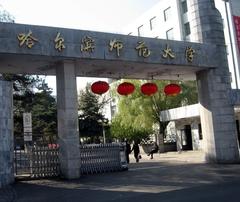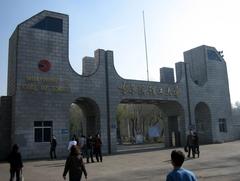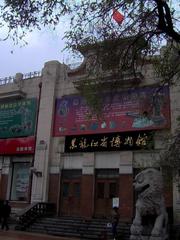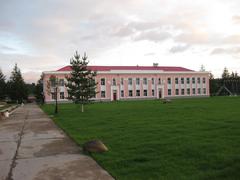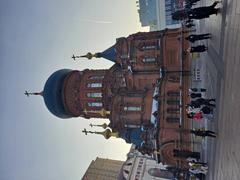Harbin Grand Theatre: Visiting Hours, Tickets, and Nearby Attractions
Date: 04/07/2025
Introduction
Nestled on the picturesque Cultural Island along the Songhua River in Harbin, Heilongjiang Province, the Harbin Grand Theatre is an architectural masterpiece and a vibrant cultural landmark. Designed by MAD Architects and completed in 2015, the theatre seamlessly fuses art, nature, and urban life. Its flowing white aluminum façade, inspired by Harbin’s northern wilderness and icy climate, has earned it international acclaim as one of the world’s most stunning modern theatres (inhabitgroup.com, area-arch.it).
More than just a visual marvel, the Harbin Grand Theatre is a dynamic hub for the performing arts, hosting a diverse array of concerts, ballet, theatre, and community events. As the anchor venue for Harbin’s renowned Ice and Snow Culture and Arts Season, it attracts visitors from across China and beyond. With visitor-friendly amenities—such as guided tours, wheelchair accessibility, and a unique 360-degree rooftop walkway—this guide offers all you need to plan your visit, including practical travel tips, ticketing, and nearby attractions (Harbin2025.com, harbinice.com, China Educational Tours).
Table of Contents
- Origins and Urban Context
- Conception and Design Competition
- Architectural Vision and Construction
- Visitor Information: Tickets, Hours, Accessibility
- Location and How to Get There
- Architectural Significance and Features
- Sustainability and Technology
- Visitor Experience
- Cultural Significance and Major Events
- Practical Tips for Visitors
- Nearby Attractions
- Booking, Guided Tours, and Contact
- Frequently Asked Questions (FAQ)
- Conclusion and Resources
Origins and Urban Context
Harbin, the capital of Heilongjiang Province, boasts a rich, multicultural history shaped by Russian, Jewish, and Chinese influences. Its transformation from a rural settlement to a cosmopolitan hub began in the late 19th century with the construction of the Chinese Eastern Railway, eventually earning it the title of UNESCO “City of Music” in 2010 (harbinice.com). The city’s ambition to enhance its cultural profile led to the creation of the Harbin Cultural Island master plan, blending nature, art, and public life along the Songhua River.
Conception and Design Competition
In 2010, MAD Architects, led by Ma Yansong, won an international competition to design the Harbin Cultural Island, with the Grand Theatre as its centerpiece. The project aimed to integrate architecture with the surrounding wetlands, making the theatre a “cultural center of the future” that harmonizes human activity, art, and nature (inhabitgroup.com, area-arch.it, divisare.com).
Architectural Vision and Construction
Site and Environmental Integration
The Grand Theatre’s sinuous form is inspired by the flowing terrain of the Songhua wetlands. During winter, the white aluminum exterior blends with the snow, reinforcing its connection to the landscape (inhabitgroup.com).
Structural and Material Innovation
Clad in custom pure white aluminum panels, the exterior evokes the purity of ice and snow and is engineered to prevent horizontal shadows. A steel skeleton supports the structure, and advanced glass curtain walls are designed to melt snow and direct runoff, addressing Harbin’s severe winters (area-arch.it, architizer.com).
Interior Spaces and Acoustics
The grand lobby features soaring glass walls and a latticed ceiling beneath a sculptural roof, inviting natural light and visually connecting the interior with the plaza (divisare.com). The main auditorium, clad in Manchurian ash wood, is designed for warmth and acoustic excellence. The theatre complex includes a 1,600-seat grand theatre and a 400-seat smaller venue with a panoramic sound-proof glass wall overlooking the wetlands.
Construction Timeline and Collaboration
Construction began soon after the 2010 competition win, with the theatre opening in 2015. The build involved collaboration with the Beijing Institute of Architectural Design, Beijing Turenscape Institute, and ECADI for acoustics, using advanced BIM modeling and innovative construction techniques (divisare.com, architizer.com).
Visitor Information: Tickets, Hours, Accessibility
- Visiting Hours: Open daily from 9:00 AM to 9:00 PM. Performance and guided tour schedules may vary; check the official website for details.
- Tickets: Performance tickets range from 80–400 RMB and can be purchased online or at the box office. Guided tours are available on select days (advance booking recommended).
- Accessibility: Fully wheelchair accessible with ramps, elevators, and assistance services on request.
- Photography: Permitted in public areas and on the rooftop; not allowed during performances.
- Rooftop Walkway: Features a unique 360° sightseeing corridor with panoramic city and wetland views (China Educational Tours).
Location and How to Get There
- Address: No. 1, Cultural Island, Songbei District, Harbin, Heilongjiang Province, China
- Public Transport: Accessible via multiple bus routes and taxi/ride-hailing services (approx. 20–40 min from downtown).
- Walking: Connected to the city via scenic bridges and walkways.
- Parking: Limited on-site; alternative parking is available nearby during major events (Trip.com, China Travel Routes).
Architectural Significance and Features
- Design Philosophy: Inspired by snow and water, the theatre’s fluid exterior channels natural forces and integrates with its environment.
- Materials: White aluminum panels, glass curtain walls, and Manchurian ash wood for warmth and acoustics.
- Interior Design: Spacious lobbies, elegant staircases, and seamless wood paneling evoke a sense of natural movement.
- Performance Spaces: Large opera hall (1,538 seats), small theatre (414 seats), multipurpose halls, and rehearsal rooms.
- Technological Innovation: Sustainable lighting, energy-efficient design, and award-winning structural engineering (inhabitgroup.com).
Sustainability and Technological Innovation
The theatre maximizes daylight, uses resource-efficient materials, and incorporates advanced snow-melting and drainage systems. It has received numerous architectural awards, including the Lu Ban China Steel Structure Gold Award (area-arch.it).
Visitor Experience
- Rooftop Sightseeing Corridor: The world’s first walkable theatre rooftop offers 360° views of Harbin, the Songhua River, and surrounding wetlands.
- Terraces and Ramps: Organic pathways encourage exploration and interaction with both the building and its natural setting.
- Amenities: Onsite cafés, lounges, gift shop, and modern restrooms enhance visitor comfort.
Cultural Significance and Major Events
Anchor of the Ice and Snow Culture and Arts Season
Each winter, the theatre hosts the Ice and Snow Culture and Arts Season, featuring over 80 performances, including symphonies, ballet, opera, and family shows (Harbin2025.com). The event brings together leading artists from China and abroad, and is a highlight of Harbin’s winter festivities.
International and Community Engagement
The theatre regularly collaborates with international companies, facilitates cultural exchange, and offers workshops, masterclasses, and educational initiatives for local residents and students.
Integration with Winter Festivals
The Grand Theatre complements Harbin’s Ice and Snow Festival, providing an elegant venue for indoor cultural experiences to pair with the city’s famous ice and snow sculptures (China Highlights).
Practical Tips for Visitors
- Best Time to Visit: Winter (Nov–Feb) for the snow and festival atmosphere; spring/autumn for milder weather (Best Time To Visit Harbin).
- What to Wear: Dress warmly in winter (temperatures often below -20°C); summer is mild but bring rain gear (Easy Tour China).
- Health and Safety: Moisturizer for dry winter air; masks for cold and dust; be prepared for stairs on the rooftop walkway.
- Language: Most signage is in Mandarin; English tours are occasionally available. Translation apps may be helpful.
Nearby Attractions
- Sun Island Scenic Area: Beautiful nature park and site of the Snow Sculpture Expo (Ice Festival Harbin).
- Saint Sophia Cathedral: Landmark Russian Orthodox church.
- Central Street (Zhongyang Dajie): Historic pedestrian shopping district.
- Siberian Tiger Park: Unique wildlife reserve.
- Harbin Cultural Center Wetland Park: Birdwatching and walking trails.
Booking, Guided Tours, and Contact
- Website: www.harbingrandtheatre.cn
- Guided Tours: Available in Mandarin, with occasional English options. Book in advance, especially during festival season.
- Customer Service: Contact via the official website (services primarily in Mandarin).
Frequently Asked Questions (FAQ)
Q: What are the Harbin Grand Theatre visiting hours?
A: Open daily from 9:00 AM to 9:00 PM; performance times vary. Check the official website for updates.
Q: How can I buy tickets?
A: Online via the official website, authorized platforms, or at the box office.
Q: Is the theatre wheelchair accessible?
A: Yes, with ramps, elevators, and accessible restrooms.
Q: Are guided tours available?
A: Yes, primarily in Mandarin, with some English tours available. Advance booking recommended.
Q: Can I take photos inside?
A: Photography is allowed in public areas and on the rooftop, but not during performances.
Q: What is the best time to visit?
A: Winter for the Ice and Snow Festival, or spring/autumn for pleasant weather and fewer crowds.
Conclusion
The Harbin Grand Theatre is a beacon of artistic innovation, seamlessly integrating cutting-edge design, natural beauty, and cultural vibrancy. Whether you are attending a world-class performance, touring its breathtaking architecture, or exploring nearby attractions, your visit promises an unforgettable experience. Plan ahead, check ticket availability, and immerse yourself in the unique fusion of art and nature that defines this landmark of the “Ice City.”
Stay updated by downloading the Audiala app for schedules, ticket offers, and insider tips. For travel inspiration and the latest performance news, follow us on social media and explore related guides on Harbin’s rich cultural scene.
Sources and Further Reading
- Harbin Grand Theatre: Visiting Hours, Tickets, and Cultural Insights, 2024
- MAD Architects - Harbin Grand Theatre Project, 2024
- Harbin Grand Theatre Architectural Details, 2024
- Harbin Grand Theatre Design and Construction, 2024
- Harbin Grand Theatre Engineering and Façade, 2024
- Harbin Grand Theatre Ice and Snow Culture and Arts Season 2025, 2024
- Harbin International Ice and Snow Festival Overview, 2024
- Harbin Grand Theatre Visitor Guide, 2024
- Harbin Cultural Island and Attractions, 2024
- China Travel Routes: Visiting Harbin Grand Theatre
- Best Time To Visit Harbin
- Harbin Grand Theatre Wikipedia
- Easy Tour China: Harbin Travel Tips
- Ice Festival Harbin: Festival Dates

